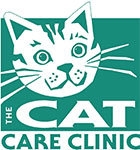We are in the 21st century, but many human medical doctors are under-informed and overprotective of pregnant women and the handling of their cats. I believe that any woman considering pregnancy should know about Toxoplasmosis, but to hear some doctors talk, if you want to get pregnant, you should get rid of your cat, and this is ridiculous. Millions if not billions of women have been exposed to cats through the ages and have somehow managed to produce healthy children.
Toxoplasma gondii is a protozoan parasite, and protozoa are a type of one-celled organism. Toxoplasmosis can occur in any mammal that ingests one of the infective stages of the protozoa. This organism has a complicated life cycle where it must spend some of its development inside a cat to be viable. The biggest threat to humans is when a pregnant woman, during her first trimester, becomes infected with the organism. An infection at this time can cause congenital malformations or mental retardation in the fetus.
Although cats are the intermediate hosts of Toxoplasma, the organism must be outside of a cat’s body for at least 24 hours before it reaches its infective stage. There are many factors, which must all come together at once to cause transmission from a cat to a human. If you have an indoor cat that never eats raw meat and never gets outside to eat birds or rodents, you are essentially at no risk. In fact 30-50% of women worldwide have been previously exposed to Toxoplasma. If a woman has been previously exposed, there is no threat to the fetus.
Cats become infected with Toxoplasma after they eat raw meat, birds, or mice carrying any of the three infective stages of the organism. The three stages are oocyst, cyst, or tachyzoite. Cats shed oocysts in their feces 3-10 days after eating infected tissues. They will shed the oocysts for up to 14 days, and it is unlikely that they will ever shed again. Within 1-4 days of being shed into the environment, the oocysts sporulate and become infectious to other animals and humans. Sporulated oocysts can live for months in the environment.
Healthy cats that are infected with Toxoplasma usually do not show any clinical signs. A cat that is also infected with Feline Leukemia or Feline Immunodeficiency virus is likely to become sick. If a cat develops Toxoplasmosis the signs of illness can range from lethargy, depression, anorexia, fever, diarrhea, pneumonia, hepatitis, uveitis (a type of inflammation of the eye), to even central nervous system disease. Healthy humans that are exposed to Toxoplasma may suffer brief illness with fever, muscle pain, enlarged lymph nodes, anorexia, and sore throat.
Toxoplasmosis can be treated with medications including pyrimethamine, sulfadiazine, and clindamycin. Aside from pregnant women, humans with immunosuppressive diseases such as AIDS are at risk. These people can develop life-threatening pneumonia or neurologic disease.
It is estimated that in some parts of the world, 10% of the lamb and 25% of the pork is infected with cysts. Cattle and goats can also be infected, so drinking unpasteurized dairy products is not recommended. There are many effective ways of minimizing exposure to Toxoplasma, with the first being to cook meat thoroughly for 15-30 minutes before eating. Keeping your cat indoors and only feeding commercially prepared cat foods is recommended.
Pregnant women and immunosuppressed humans can take these precautions:
1. Wear rubber gloves and wash hands thoroughly after outdoor gardening. The sporulated oocysts can live for long periods of time in dirt and sand.
2. Cover up children’s sandboxes when not in use to prevent cats from using them as litterboxes and depositing oocysts.
3. Empty litterboxes daily so that oocysts will not have the opportunity to sporulate. Wear rubber gloves for this job or have another family member do it.
4. Eat only thoroughly cooked meat and wash hands vigorously if you handle raw meat or vegetables.
5. Drink only pasteurized dairy products.
6. Test yourself for antibodies to Toxoplasma gondii. If you are already positive, there is little risk unless you are immunosuppressed.
7. Wash your hands after coming in contact with any cat.
Some medical doctors recommend that household cats should be tested for Toxoplasma. I do not usually make this recommendation, because a person’s status is more important than the animal’s status. If you do choose to test your cat(s), keep in mind that healthy cats with positive tests are likely immune and not shedding infective oocysts. Healthy cats with negative tests could become exposed and shed for up to 2 weeks, if given the opportunity to eat raw meat or hunt.
Toxoplasmosis is not the only danger that pregnant women or immunocompromised patients face, and the bottom line is that using good hygiene and eating only cooked meats will prevent problems. This is not a new health issue, and pregnant cat owners should not be scared of their cats. The companionship and love that a pet cat provides far outweighs any risks of exposure. If you have any questions on Toxoplasmosis, you should consult with your medical doctor and your veterinarian.
Written by Dr. Wexler-Mitchell of The Cat Care Clinic in Orange, CA
Copyright © 2011 The Cat Care Clinic
